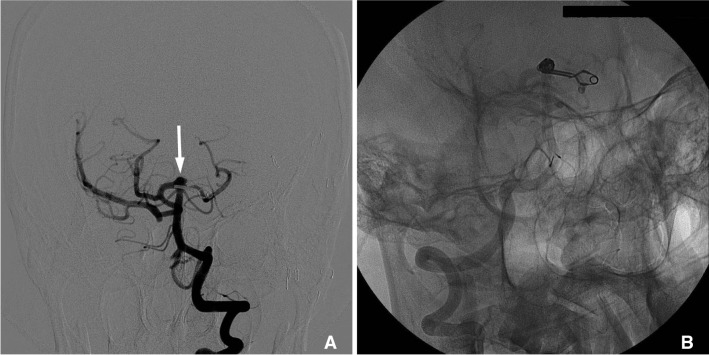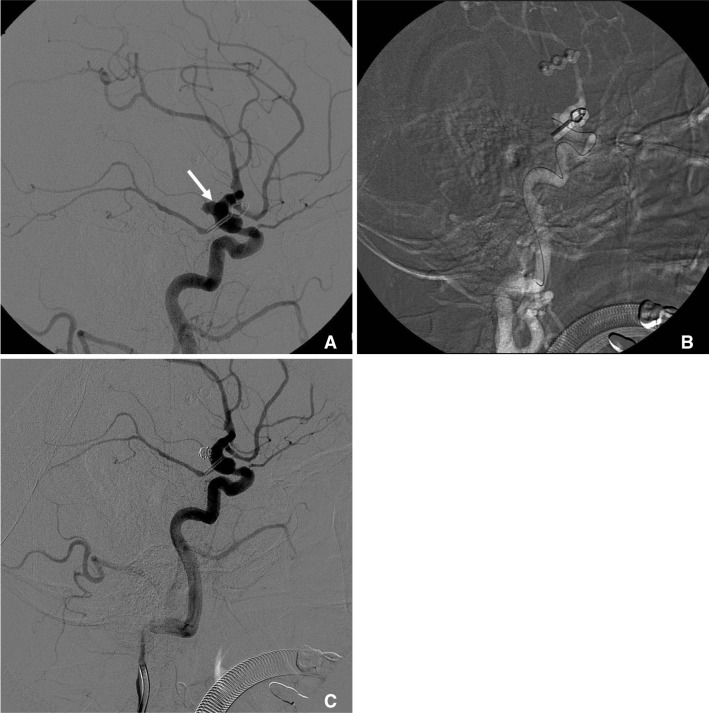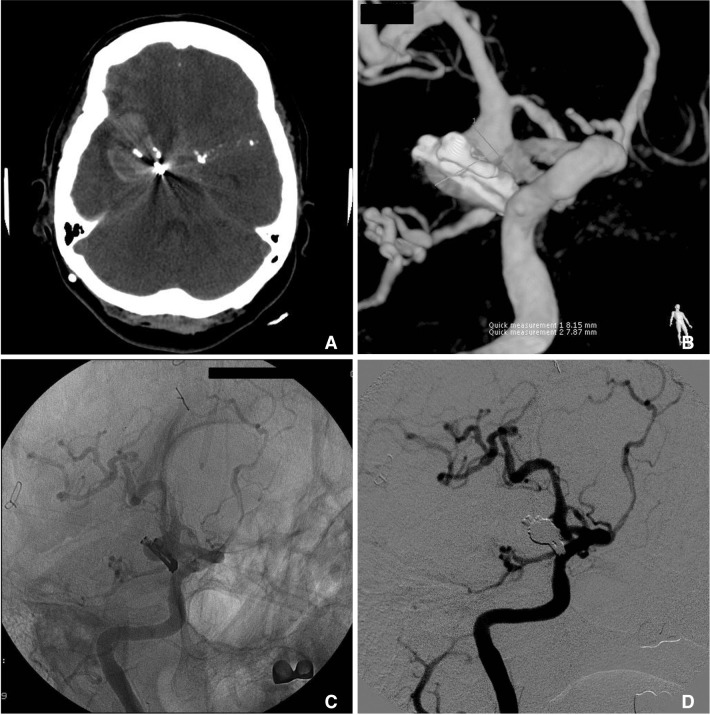Neurointervention.
2013 Feb;8(1):46-51. 10.5469/neuroint.2013.8.1.46.
Coiling as Retreatment in Intracranial Aneurysm of de novo Formation or Regrowth: Case Report
- Affiliations
-
- 1Department of Neurosurgery, Busan Paik Hospital, Inje University, Busan, Korea.
- 2Department of Diagnostic Radiology, Busan Paik Hospital, Inje University, Busan, Korea. kimst015@hanmail.net
- KMID: 2052081
- DOI: http://doi.org/10.5469/neuroint.2013.8.1.46
Abstract
- Development of de novo aneurysm or aneurysm regrowth after complete clipping of an intracranial aneurysm is rare. We report coiled cases of de novo aneurysm and aneurysm regrowth. We retrospectively reviewed 107 cases of intracranial aneurysm coiling performed in our hospital, identifying five cases of coiled aneurysm that were de novo aneurysm or aneurysm regrowth. In all the cases, total or near total occlusion was seen. There were no complications related to the procedure. In two of the three patients with ruptured aneurysms, consciousness level on admission was stupor. When the patient was discharged after the treatment, one of them had 4 of the modified Rankin Scale. The other one had 5 on discharge. The rest three patients had 0. As for a de novo aneurysm or a regrowth of aneurysm, coiling may be considered when clipping is difficult.
MeSH Terms
Figure
Reference
-
1. Asgari S, Wanke I, Schoch B, Stolke D. Recurrent hemorrhage after initially complete occlusion of intracranial aneurysms. Neurosurg Rev. 2003; 26:269–274. PMID: 12802695.
Article2. Tsutsumi K, Ueki K, Morita A, Usui M, Kirino T. Risk of aneurysm recurrence in patients with clipped cerebral aneurysms : results of long-term follow-up angiography. Stroke. 2001; 32:1191–1194. PMID: 11340232.3. Molyneux AJ, Kerra RSC, Birksb J, Ramzia N, Yarnolda J. ISAT collaborators. Risk of recurrent subarachnoid haemorrhage, death, or dependence and standardised mortality ratios after clipping or coiling of an intracranial aneurysm in the International Subarachnoid Aneurysm Trial (ISAT): long-term follow-up. Lancet Neurol. 2009; 8:427–433. PMID: 19329361.
Article4. Schaafsma JD, Sprengers ME, van Rooij WJ, Sluzewski M, Majoie CB, Wermer MJ, et al. Long-Term recurrent subarachnoid hemorrhage after adequate coiling versus clipping of ruptured intracranial aneurysms. Stroke. 2009; 40:1758–1763. PMID: 19286603.
Article5. Tsutsumi K, Ueki K, Usui M, Kwak S, Kirino T. Risk of subarachnoid hemorrhage after surgical treatment of unruptured cerebral aneurysms. Stroke. 1999; 30:1181–1184. PMID: 10356096.
Article6. Johnston SC, Dowd CF, Higashida RT, Lawton MT, Duckwiler GR, Gress DR. CARAT Investigators. Predictors of rehemorrhage after treatment of ruptured intracranial aneurysms: the Cerebral Aneurysm Rerupture After Treatment (CARAT) study. Stroke. 2008; 39:120–125. PMID: 18048860.7. Byrne JV, Sohn M, Molyneux AJ. Five-year experience in using coil Embolization for ruptured intracranial aneurysms: outcomes and Incidence of late rebleeding. J Neurosurg. 1999; 90:656–663. PMID: 10193610.
Article8. Wermer MJ, vander Schaaf IC, Velthuis BK, Algra A, Buskens E, Rinkel GJ. ASTRA Study Group. Follow-up screening after subarachnoid haemorrhage: frequency and determinants of new aneurysms and enlargement of existing aneurysms. Brain. 2005; 128(Pt 10):2421–2429. PMID: 16000333.
Article9. Kim BM, Kim DJ, Kim DI, Park SI, Suh SH, Won YS. Clinical presentation and outcomes of coil embolization of remnant or recurred intracranial aneurysm after clipping. Neurosurgery. 2010; 66:1128–1133. PMID: 20495427.
Article10. Nakase H, Kamada Y, Aoki H, Goda K, Morimoto T, Sasaki T. Clinical study on recurrent intracranial aneurysm. Cerebrovasc Dis. 2000; 10:255–260. PMID: 10878429.11. Tonn J, Hoffmann O, Hofmann E, Schlake HP, Sörensen N, Roosen K. "De novo" formation of intracranial aneurysms: who is at risk? Neuroradiology. 1999; 41:674–679. PMID: 10525770.
Article12. Wermer MJ, Rinkel GJ, Greebe P, Albrecht KW, Dirven CM, Tulleken CA. Late recurrence of subarachnoid hemorrhage after treatment for ruptured aneurysms: patient characteristics and outcomes. Neurosurgery. 2005; 56:197–204. PMID: 15670367.
Article13. Bendok BR, Ali MJ, Malisch TW, Russell EJ, Batjer HH. Coiling of cerebral aneurysm remnants after clipping. Neurosurgery. 2002; 51:693–697. PMID: 12188947.
Article14. Forsting M, Albert FK, Jansen O, von Kummer R, Aschoff A, Kunze S, et al. Coil placement after clipping: endovascular treatment of incompletely clipped aneurysms. Report of two cases. J Neurosurg. 1996; 85:966–969. PMID: 8893741.
- Full Text Links
- Actions
-
Cited
- CITED
-
- Close
- Share
- Similar articles
-
- Intracranial "De Novo" Aneurysms: Case Report
- Rupture of De Novo Anterior Communicating Artery Aneurysm 8 Days after the Clipping of Ruptured Middle Cerebral Artery Aneurysm
- De novo Formation of Familial Cerebral Aneurysms
- Regrowth of Posterior Communicating Artery Aneurysm after 13 Years of the First Clipping: A Case Report
- A Case of the Simultaneous Occurrence of Spontaneous Regression and De Novo Formation of the Intracranial Aneurysms




